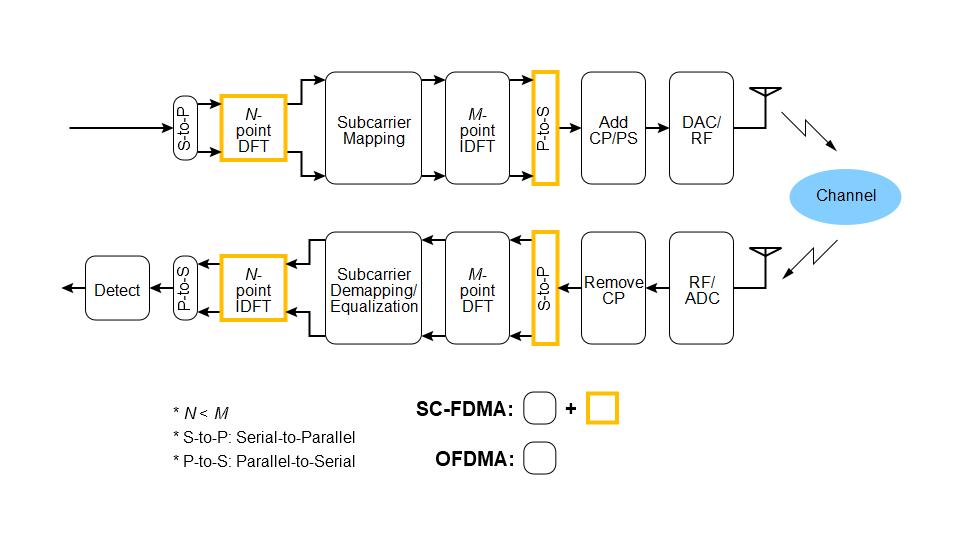
|
vlrPhone |
Multimedia Codecs Based on FFT and usable with OFDM, OFDMA and SC-FDMA

Multimedia Codecs Based on FFT and usable with OFDM, OFDMA and SC-FDMA
This information is written for investors, developers and decision makers.
In a recent paper, we presented new algorithms for data compression via FFT (Fast Fourier Transform) and the transport of this data.
See at the following addresses:
Image and Video Compression
Long Distance Communications
This document aims to provide clarifications and supplements, in relation to OFDM (Orthogonal Frequency Division Multiplexing), OFDMA (Orthogonal Frequency Division Multiple Access), and SC-FDMA (Single-Carrier Frequency Division Multiple Access).
For more information on these methods, see at the following addresses:
OFDM
OFDMA
SC-FDMA
The SC-FDMA is used particularly in terrestrial-satellite communications and in the uplink transmission direction (terminal to relay antenna) of 4G LTE and LTE-Advanced mobile networks.
In the frequency domain, with the FFT codecs in question, we use the largest points and the most energetic bands.
We can use decimations in the bands (retain only the largest point among N consecutive points). The phases are ignored in the background, we only keep the sign of the phase or we implement another optimization with the sign of the phases.
The obtained codes can be used directly to ensure precoding in SC-FDMA, and avoid additional FFTs.
In a long-distance communication context, with a minimized PAPR (Peak to Average Power Ratio), by transporting the foreground points in the background phases, the obtained codes can be used directly in OFDM and OFDMA communications.
Our codecs are oriented towards media compression (audio, image, video) using FFT. We can use other data sources and come back to FFT and two plans:
- Huffman stream (stream from Huffman coding):
The least frequent points are matched to the points in the foreground of the FFT encoder output, the number of successive repetitions up to a certain limit being contained in the phase, and the other points are matched to the background of the FFT encoder. Successive repetitions in the background are ignored. Finally, the signs of the phases in the background are alternated.
See a more detailed description in the USPTO patent document.
- RLE (Run Length Encoding) stream:
The values to be repeated are matched to magnitudes and the number of repetitions, up to a certain limit, to phases.
Either two UNB frames are transmitted, or the background is completely generated or completed and the foreground points are transported into the background bands.
See a more detailed description in the USPTO patent document.
- General case:
Our methods are applicable to pure data. From a normal FFT frame with a high PAPR:
- Remove the foreground.
- Create two frames with the cosine amplitudes and the sine amplitudes. Each frame can be considered as a FFT frame without phase.
- Put the foreground in the background phases. This gives two normal FFT frames with a lower PAPR.
Upon the reception of the two frames, find the foreground and background without loss.
This method is less efficient than with a single frame, but in a long distance context or longer distance in difficult area, the error correction by redundancy is essential, there are more bins available to implement the redundancy (data to put in the phases, the empty spaces caused by the removal of the foreground can be used with caution).
The UNB (Ultra Narrow Band) frames can be used as OFDM, OFDMA or SC-FDMA bins.
The UNB frames described in our methods are low quality media frames, but:
- In the context of AI (Artificial Intelligence), especially generative AI, they can be transformed into high quality media frames.
- They can also be generated from DCT (Discrete Cosine Transform), MDCT (Modified Discrete Cosine Transform) or Real DWT (Discrete Wavelet Transform).
- Taken as OFDM, OFDMA or SC-FDMA bins, they have the particularity of being very easy to manipulate (in addition, deletion, or mixed mode), by playing only with the signs of the global phases.
- We can also play with the spacings and the global coefficients applied to the magnitudes of the UNB frames to approximate a particular signal in the time domain.